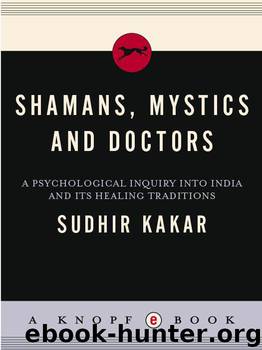Shamans, Mystics, and Doctors by Kakar Sudhir

Author:Kakar, Sudhir [Kakar, Sudhir]
Language: eng
Format: epub
ISBN: 9780307831798
Publisher: Knopf Doubleday Publishing Group
Published: 2013-04-02T18:30:00+00:00
Tantric Techniques
Irrespective of the path a tantrik chooses or—in case of a kula—is born into, the use of mantra in tantric sadhana is common to all traditions. Mantra is so central to tantrism that tantriks are often called mantriks and tantra itself is seen as synonymous with mantra-shastra—the science of mantra. Since my aim here is a psychological account of tantrism and particularly of its psychotherapeutic aspect, I will not go into the formal, ritual and metaphysical aspects of mantra which have been comprehensively discussed by other scholars.34
In popular Hindu culture, a mantra is considered a sacred yet magical formula, whose rhythmical repetition (japa) can fulfill many desired purposes. Mantras, it is held, aid a person to ward off evil spirits, propitiate wrathful gods and goddesses and help in the acquisition of religious merit. They are also believed to encourage friendly supernatural powers to intercede on the mantra user’s behalf in the more mundane matters: for instance, in ensuring the favorable outcome of a court case, the birth of a son rather than a daughter, the spiting of an enemy, the acquisition of wealth that does not have to be worked for and other such desirable matters. In tantric practice, the use of mantra is more sophisticated. Mantra japa (silent or otherwise) holds a preeminent position in realization of the tantric goals of establishing the adept’s identity with a goddess and in helping the tantrik to “concentrate” and enter a desired psychic state.
Essentially, a mantra is a sequence of sound units or sphotas (Bharati calls them morphemes)35 with a characteristic pronunciation and intonation which the disciple normally learns from the guru. The major constituent of a mantra is a combination of bijas (seeds). A bija is a syllable without apparent meaning yet possesses the greatest significance for the initiate. To me, bijas appear to be aural symbols for certain forms of inner psychological experience ranging from simple sensations to more complex emotional states. Thus the bija “Am” is connected to the sensation of starting, being ready to begin, genesis; “Ram” is connected to burning; “Ham” is connected with the blowing of wind and the sensation of being carried up, whirled away and so on. Other, complex bijas symbolize particular emotional states: for instance “Klim” is regarded as the bija of erotic desire, “Aim” of wonder, and “Sauh” of fulfillment or “of what the infant vocalizes when he is replete with milk.”
My tantrik informants (as well as the texts) insisted that the connection between a bija and its corresponding psychic state was not merely symbolic. A bija intonated properly and repeated according to instructions, they maintained, produced certain vibrations (spanda) which, acting through an unknown physiological process, created characteristic emotional states. In other words, each psychic state has a corresponding sound pattern and the activation of this sound pattern can evoke the particular psychic state. My own suggestion that the association between a bija and a psychic state was established by the awesome authority of the guru, supported by the belief
Download
This site does not store any files on its server. We only index and link to content provided by other sites. Please contact the content providers to delete copyright contents if any and email us, we'll remove relevant links or contents immediately.
Becoming Supernatural by Dr. Joe Dispenza(8127)
Crystal Healing for Women by Mariah K. Lyons(7857)
The Witchcraft of Salem Village by Shirley Jackson(7193)
Inner Engineering: A Yogi's Guide to Joy by Sadhguru(6728)
The Four Agreements by Don Miguel Ruiz(6638)
The Power of Now: A Guide to Spiritual Enlightenment by Eckhart Tolle(5610)
Secrets of Antigravity Propulsion: Tesla, UFOs, and Classified Aerospace Technology by Ph.D. Paul A. Laviolette(5311)
The Wisdom of Sundays by Oprah Winfrey(5087)
Room 212 by Kate Stewart(5041)
Pale Blue Dot by Carl Sagan(4917)
Fear by Osho(4662)
The David Icke Guide to the Global Conspiracy (and how to end it) by David Icke(4629)
Animal Frequency by Melissa Alvarez(4399)
Rising Strong by Brene Brown(4380)
How to Change Your Mind by Michael Pollan(4292)
Sigil Witchery by Laura Tempest Zakroff(4181)
Real Magic by Dean Radin PhD(4075)
Man and His Symbols by Carl Gustav Jung(4070)
The Art of Happiness by The Dalai Lama(4063)
